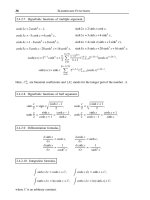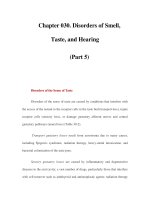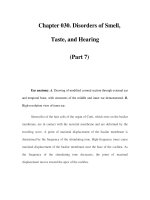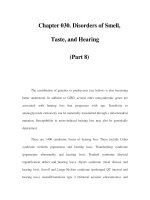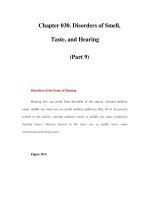Chapter 030. Disorders of Smell, Taste, and Hearing (Part 11) ppsx
Bạn đang xem bản rút gọn của tài liệu. Xem và tải ngay bản đầy đủ của tài liệu tại đây (70.88 KB, 5 trang )
Chapter 030. Disorders of Smell,
Taste, and Hearing
(Part 11)
Approach to the Patient: Disorders of the Sense of Hearing
The goal in the evaluation of a patient with auditory complaints is to
determine (1) the nature of the hearing impairment (conductive vs. sensorineural
vs. mixed), (2) the severity of the impairment (mild, moderate, severe, profound),
(3) the anatomy of the impairment (external ear, middle ear, inner ear, or central
auditory pathway), and (4) the etiology. The history should elicit characteristics of
the hearing loss, including the duration of deafness, unilateral vs. bilateral
involvement, nature of onset (sudden vs. insidious), and rate of progression (rapid
vs. slow). Symptoms of tinnitus, vertigo, imbalance, aural fullness, otorrhea,
headache, facial nerve dysfunction, and head and neck paresthesias should be
noted. Information regarding head trauma, exposure to ototoxins, occupational or
recreational noise exposure, and family history of hearing impairment may also be
important. A sudden onset of unilateral hearing loss, with or without tinnitus, may
represent a viral infection of the inner ear or a stroke. Patients with unilateral
hearing loss (sensory or conductive) usually complain of reduced hearing, poor
sound localization, and difficulty hearing clearly with background noise. Gradual
progression of a hearing deficit is common with otosclerosis, noise-induced
hearing loss, vestibular schwannoma, or Ménière's disease. Small vestibular
schwannomas typically present with asymmetric hearing impairment, tinnitus, and
imbalance (rarely vertigo); cranial neuropathy, in particular of the trigeminal or
facial nerve, may accompany larger tumors. In addition to hearing loss, Ménière's
disease may be associated with episodic vertigo, tinnitus, and aural fullness.
Hearing loss with otorrhea is most likely due to chronic otitis media or
cholesteatoma.
Examination should include the auricle, external ear canal, and tympanic
membrane. The external ear canal of the elderly is often dry and fragile; it is
preferable to clean cerumen with wall-mounted suction and cerumen loops and to
avoid irrigation. In examining the eardrum, the topography of the tympanic
membrane is more important than the presence or absence of the light reflex. In
addition to the pars tensa (the lower two-thirds of the eardrum), the pars flaccida
above the short process of the malleus should also be examined for retraction
pockets that may be evidence of chronic eustachian tube dysfunction or
cholesteatoma. Insufflation of the ear canal is necessary to assess tympanic
membrane mobility and compliance. Careful inspection of the nose, nasopharynx,
and upper respiratory tract is indicated. Unilateral serous effusion should prompt a
fiberoptic examination of the nasopharynx to exclude neoplasms. Cranial nerves
should be evaluated with special attention to facial and trigeminal nerves, which
are commonly affected with tumors involving the cerebellopontine angle.
The Rinne and Weber tuning fork tests, with a 512-Hz tuning fork, are used
to screen for hearing loss, differentiate conductive from sensorineural hearing
losses, and to confirm the findings of audiologic evaluation. Rinne's test compares
the ability to hear by air conduction with the ability to hear by bone conduction.
The tines of a vibrating tuning fork are held near the opening of the external
auditory canal, and then the stem is placed on the mastoid process; for direct
contact, it may be placed on teeth or dentures. The patient is asked to indicate
whether the tone is louder by air conduction or bone conduction. Normally, and in
the presence of sensorineural hearing loss, a tone is heard louder by air conduction
than by bone conduction; however, with conductive hearing loss of ≥30 dB (see
"Audiologic Assessment," below), the bone-conduction stimulus is perceived as
louder than the air-conduction stimulus. For the Weber test, the stem of a vibrating
tuning fork is placed on the head in the midline and the patient asked whether the
tone is heard in both ears or better in one ear than in the other. With a unilateral
conductive hearing loss, the tone is perceived in the affected ear. With a unilateral
sensorineural hearing loss, the tone is perceived in the unaffected ear. A 5-dB
difference in hearing between the two ears is required for lateralization.
Laboratory Assessment of Hearing
Audiologic Assessment
The minimum audiologic assessment for hearing loss should include the
measurement of pure tone air-conduction and bone-conduction thresholds, speech
reception threshold, discrimination score, tympanometry, acoustic reflexes, and
acoustic-reflex decay. This test battery provides a screening evaluation of the
entire auditory system and allows one to determine whether further differentiation
of a sensory (cochlear) from a neural (retrocochlear) hearing loss is indicated.
Pure tone audiometry assesses hearing acuity for pure tones. The test is
administered by an audiologist and is performed in a sound-attenuated chamber.
The pure tone stimulus is delivered with an audiometer, an electronic device that
allows the presentation of specific frequencies (generally between 250 and 8000
Hz) at specific intensities. Air and bone conduction thresholds are established for
each ear. Air conduction thresholds are determined by presenting the stimulus in
air with the use of headphones. Bone conduction thresholds are determined by
placing the stem of a vibrating tuning fork or an oscillator of an audiometer in
contact with the head. In the presence of a hearing loss, broad-spectrum noise is
presented to the nontest ear for masking purposes so that responses are based on
perception from the ear under test.
